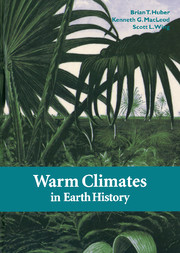Book contents
- Frontmatter
- Contents
- List of contributors
- Preface
- Part 1 Approaches to the study of paleoclimates
- Part II Case studies: latest Paleocene–early Eocene
- Part III Case studies: Mesozoic
- 8 Paleontological and geochemical constraints on the deep ocean during the Cretaceous greenhouse interval
- 9 Late Cretaceous climate, vegetation, and ocean interactions
- 10 Jurassic phytogeography and climates: new data and model comparisons
- Part IV Case studies: Paleozoic
- Part V Overview: climate across tectonic timescales
- Index
- Plate section
9 - Late Cretaceous climate, vegetation, and ocean interactions
from Part III - Case studies: Mesozoic
Published online by Cambridge University Press: 06 July 2010
- Frontmatter
- Contents
- List of contributors
- Preface
- Part 1 Approaches to the study of paleoclimates
- Part II Case studies: latest Paleocene–early Eocene
- Part III Case studies: Mesozoic
- 8 Paleontological and geochemical constraints on the deep ocean during the Cretaceous greenhouse interval
- 9 Late Cretaceous climate, vegetation, and ocean interactions
- 10 Jurassic phytogeography and climates: new data and model comparisons
- Part IV Case studies: Paleozoic
- Part V Overview: climate across tectonic timescales
- Index
- Plate section
Summary
ABSTRACT
General Circulation Models (GCMs) have had difficulty simulating the low meridional thermal gradients and warm winter continents characteristic of the Late Cretaceous and other warm paleoclimatic periods, forcing both the validity of the models and interpretations of the proxy climate data to be questioned. In a new approach to pre-Quaternary paleoclimate modeling, Campanian (80 Ma) climate and vegetation have been simulated using a GCM, interactively coupled to a predictive vegetation model (DeConto et al., 1998, 1999a,b). This climate–vegetation simulation reproduced the overall warmth, warm polar temperatures, and warm winter continental interiors characteristic of the Late Cretaceous geologic record. High latitude forests played an important role in the maintenance of polar warmth and equable continental interiors both directly and indirectly. The model required 1500 ppm atmospheric CO2 (about 4.4 times present-day value) and 2 × 10 W poleward ocean heat transport to maintain high-polar latitude forests. Smaller values of atmospheric C02 and poleward ocean heat transport predicted replacement of forest with tundra in high latitude continental interiors and cold (especially winter and spring) temperatures. To determine if the Late Cretaceous ocean could maintain low meridional thermal gradients an Ocean General Circulation Model (OGCM) was forced by the Campanian climate simulated by the climate-vegetation model (Brady et al, 1998). The OGCM predicts that most of the Campanian ocean heat transport is through meridional overturning, with most deep water formation occurring at high southern latitudes in a process similar to that found in today's North Atlantic.
- Type
- Chapter
- Information
- Warm Climates in Earth History , pp. 275 - 296Publisher: Cambridge University PressPrint publication year: 1999
- 15
- Cited by

